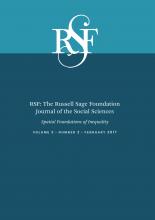Research Article
Open Access
Racial Residential Segregation of School-Age Children and Adults: The Role of Schooling as a Segregating Force
Ann Owens
RSF: The Russell Sage Foundation Journal of the Social Sciences February 2017, 3 (2) 63-80; DOI: https://doi.org/10.7758/RSF.2017.3.2.03
Ann Owens
aAssistant professor of sociology at the University of Southern California and an affiliate of the Spatial Sciences Institute, Population Research Center, and Sol Price Center for Social Innovation at USC

REFERENCES
- ↵
- Bayer, Patrick,
- Fernando Ferreira, , and
- Robert McMillan
- ↵
- Black, Sandra E
- ↵
- Charles, Camille Zubrinsky
- ↵
- Crowder, Kyle D
- ↵Frey, William H. 2014. “New Projections Point to a Majority Minority Nation in 2044.” Washington, D.C.: Brookings Institution Press.
- ↵
- ↵Grady, Sarah, and Stacey Bielick. 2010. “Trends in the Use of School Choice: 1993 to 2007.” NCES 2010–004. Washington: U.S. Department of Education.
- ↵
- Harris, David R
- ↵Henig, Jeffrey. 1996. “The Local Dynamics of Choice: Ethnic Preferences and Institutional Responses.” In Who Chooses? Who Loses? Cluture, Institutions, and the Unequal Effects of School Choice, edited by Bruce Fuller, Richard F. Elmore, and Gary Orfield. New York: Teachers College Press.
- ↵
- Holme, Jennifer Jellison
- ↵
- ↵Jargowsky, Paul A. 2014. “Segregation, Neighborhoods, and Schools.” In Choosing Homes, Choosing Schools, edited by Annette Lareau and Kimberly Goyette. New York: Russell Sage Foundation.
- ↵Jencks, Christopher, and Susan E. Mayer. 1990. “The Social Consequences of Growing Up in a Poor Neighborhood.” In Inner-City Poverty in the United States, edited by Laurence E. Lynne and Michael G. H. McGreary. Washington, D.C.: National Academies Press.
- ↵
- Krysan, Maria
- ↵Lankford, Hamilton, and James Wyckoff. 2006. “The Effect of School Choice and Residential Location on the Racial Segregation of Students.” In Advances in Applied Microeconomics, vol. 14. Improving School Accountability, edited by Timothy J. Gronberg and Dennis W. Jansen. Amsterdam: Elsevier.
- ↵Lareau, Annette. 2014. “Schools, Housing, and the Reproduction of Inequality.” In Choosing Homes, Choosing Schools, edited by Annette Lareau and Kimberly A. Goyette. New York: Russell Sage Foundation.
- ↵
- Leventhal, Tama, and
- Jeanne Brooks-Gunn
- ↵Logan, John R., Deirdre Oakley, Polly Smith, Jacob Stowell, and Brian Stults. 2001. “Separating the Children.” Lewis Mumford Center report. Albany: State University of New York.
- ↵Logan, John R., and Brian J. Stults. 2011. “The Persistence of Segregation in the Metropolis: New Findings from the 2010 Census.” Project US2010 census brief. Providence, R.I.: Brown University. Accessed June 26, 2016. http://www.s4.brown.edu/us2010/Data/Report/report2.pdf.
- ↵
- ↵
- Massey, Douglas S., and
- Nancy A. Denton
- ↵Missouri Census Data Center. 2012. “MABLE/Geocorr Geographic Correspondence Engine.” Accessed June 26, 2016. http://mcdc.missouri.edu/websas/geocorr12.html.
- ↵
- Nguyen-Hoang, Phuong, and
- John Yinger
- ↵Orfield, Gary, and Erica Frankenberg. 2014. “Brown at 60: Great Progress, a Long Retreat, and an Uncertain Future.” Los Angeles, Calif.: Civil Rights Project/Proyecto Derechos Civiles. Accessed June 23, 2016. https://civilrightsproject.ucla.edu/research/k-12-education/integration-and-diversity/brown-at-60-great-progress-a-long-retreat-and-an-uncertain-future/Brown-at-60-051814.pdf.
- ↵
- ↵
- ↵
- ↵
- ↵
- Reardon, Sean F.,
- John T. Yun, , and
- Tamela McNulty Eitle
- ↵Rhodes, Anna, and Stefanie DeLuca. 2014. “Residential Mobility and School Choice Among Poor Families.” In Choosing Homes, Choosing Schools, edited by Annette Lareau and Kimberly A. Goyette. New York: Russell Sage Foundation.
- ↵
- Sampson, Robert J.,
- Jeffrey D Morenoff, , and
- Thomas Gannon-Rowley
- ↵
- ↵Saporito, Salvatore, and Caroline Hanley. 2014. “Declining Significance of Race?” In Choosing Homes, Choosing Schools, edited by Annette Lareau and Kimberly A. Goyette. New York: Russell Sage Foundation.
- ↵
- ↵
- Saporito, Salvatore, and
- Deenesh Sohoni
- ↵
- ↵
- ↵
- South, Scott J., and
- Kyle D. Crowder
- ↵
- ↵Theil, Henri. 1972. Statistical Decomposition Analysis, vol. 14. Amsterdam: North-Holland Publishing.
- ↵
- Theil, Henri, and
- Anthony J. Finezza
- ↵U.S. Census Bureau. 2000. “Summary Tape File 1, Tables P4, P6, P26, P34, PCT12.” Washington: U.S. Department of Commerce.
- ↵U.S. Census Bureau. 2010. “Summary Tape File 1, Tables P9, P11, P18, P38, PCT12.” Washington: U.S. Department of Commerce.
- ↵Wells, Amy Stuart. 1996. “African-American Students’ View of School Choice.” In Who Chooses? Who Loses? Cluture, Institutions, and the Unequal Effects of School Choice, edited by Bruce Fuller, Richard F. Elmore, and Gary Orfield. New York: Teachers College Press.
In this issue
Racial Residential Segregation of School-Age Children and Adults: The Role of Schooling as a Segregating Force
Ann Owens
RSF: The Russell Sage Foundation Journal of the Social Sciences Feb 2017, 3 (2) 63-80; DOI: 10.7758/RSF.2017.3.2.03
Jump to section
- Article
- Abstract
- RESIDENTIAL SEGREGATION AMONG CHILDREN AND ADULTS
- THE ROLE OF SCHOOLS IN RESIDENTIAL SEGREGATION
- DATA AND METHODS
- RACIAL INTERACTION AND ISOLATION
- RACIAL EVENNESS ACROSS NEIGHBORHOODS
- RACIAL EVENNESS ACROSS NEIGHBORHOODS WITHIN AND BETWEEN SCHOOL DISTRICTS
- DISCUSSION
- Acknowledgments
- Appendix
- FOOTNOTES
- REFERENCES
- Figures & Data
- Info & Metrics
- References
Related Articles
- No related articles found.
Cited By...
- No citing articles found.





